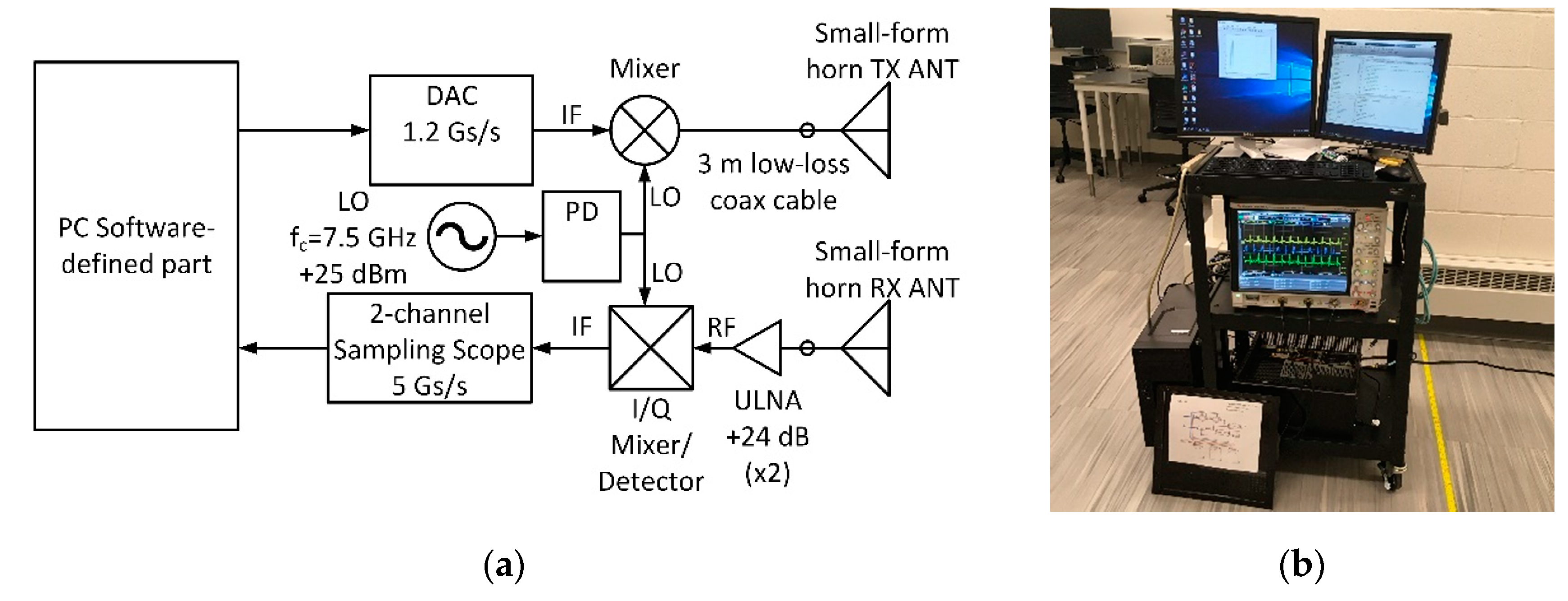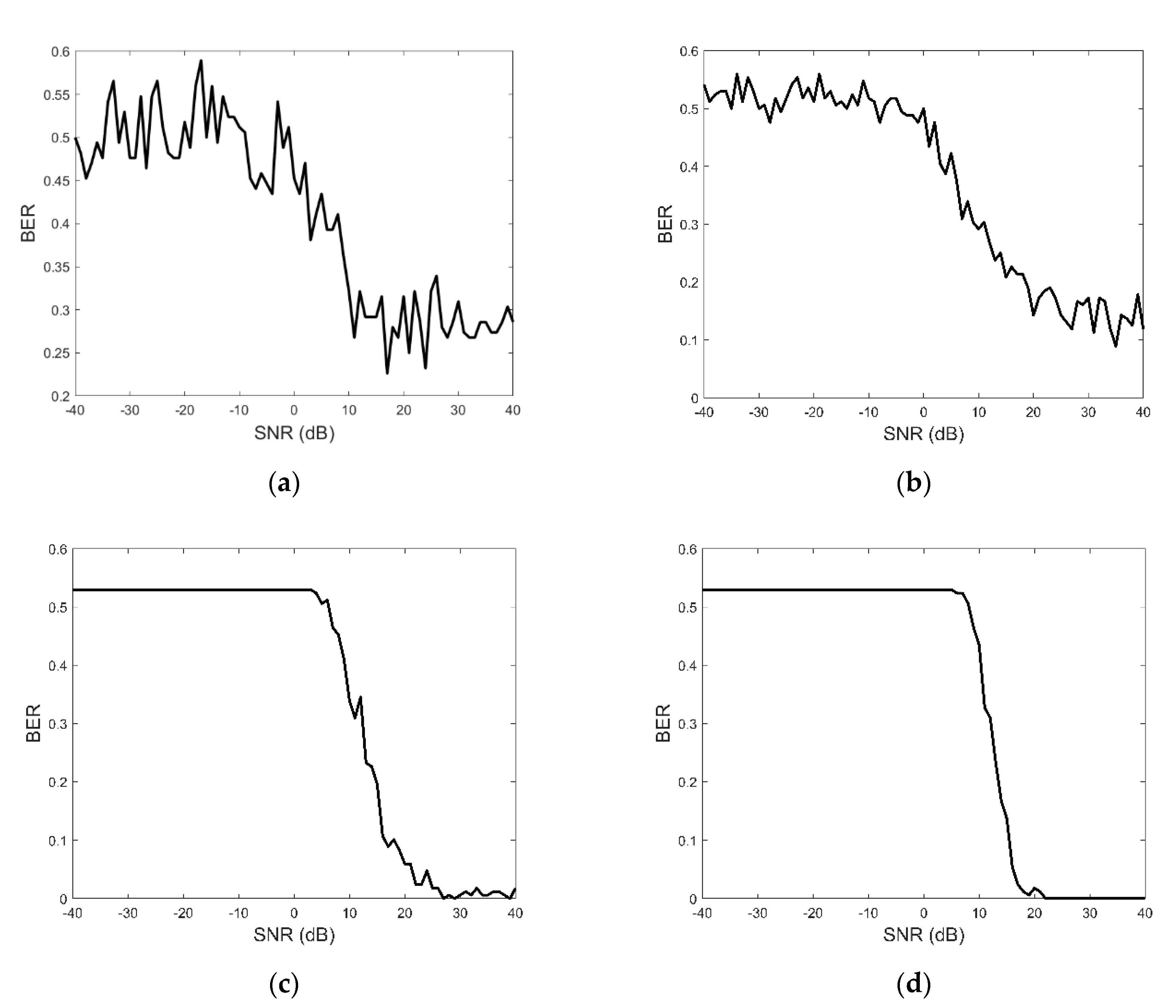Clutter-Masked Waveform Design for LPI/LPD Radarcom Signal Encoding
Abstract
1. Introduction
2. RSE Approach to Signal Design
3. Clutter Distribution Deconvolution from Noise
4. Clutter Modeling from Experimental Data
5. Clutter-Masked Radarcom Waveform Performance Evaluation
5.1. Transmit Waveform Design
5.2. Intercepted Signal Classification by Unauthorized Receivers
5.3. Clutter-Masked Communication Performance
5.4. Radar Performance
6. Conclusions
Author Contributions
Funding
Institutional Review Board Statement
Informed Consent Statement
Data Availability Statement
Acknowledgments
Conflicts of Interest
References
- Sturm, S.; Wiesbeck, W. Waveform design and signal processing aspects for fusion of wireless communications and radar sensing. Proc. IEEE 2011, 99, 1236–1259. [Google Scholar] [CrossRef]
- Liu, F.; Zhou, L.; Masouros, C.; Li, L.; Luo, W.; Petropulu, A. Toward dual-functional radar-communication systems: Optimal waveform design. IEEE Trans. Signal Process. 2018, 66, 4264–4279. [Google Scholar] [CrossRef]
- Surender, S.C.; Narayanan, R.M. UWB noise-OFDM netted radar: Physical layer design and analysis. IEEE Trans. Aerosp. Electron. Syst. 2011, 47, 1380–1400. [Google Scholar] [CrossRef]
- Metcalf, J.G.; Sahin, C.; Blunt, S.D.; Rangaswamy, M. Analysis of symbol-design strategies for intrapulse radar-embedded communications. IEEE Trans. Aerosp. Electron. Syst. 2015, 51, 2914–2931. [Google Scholar] [CrossRef]
- Kellett, D.; Garmatyuk, D.; Mudaliar, S.; Condict, N.; Qualls, I. Random sequence encoded waveforms for covert asynchronous communications and radar. IET Radar Sonar Navig. 2019, 13, 1713–1720. [Google Scholar] [CrossRef]
- Guerci, J. Space-Time Adaptive Processing for Radar, 2nd ed.; Artech House: Norwood, MA, USA, 2015. [Google Scholar]
- Wang, Y.; Zha, Y.; Huang, Y.; Zhang, Y.; Yang, J. A deconvolution method for ship detection in sea clutter environment. In Proceedings of the 2015 IEEE International Geoscience and Remote Sensing Symposium (IGARSS), Milan, Italy, 26–31 July 2015. [Google Scholar]
- Cao, C.; Meng, J.; Zhang, X.; Zhang, Z.; Yue, J. Clutter suppression and moving target indication with airborne wide-area surveillance radar. In Proceedings of the 2016 CIE International Conference on Radar (RADAR), Guangzhou, China, 10–13 October 2016. [Google Scholar]
- Rangaswamy, M.; Weiner, D.; Ozturk, A. Computer generation of correlated non-Gaussian radar clutter. IEEE Trans. Aerosp. Electron. Syst. 1995, 31, 106–116. [Google Scholar] [CrossRef]
- Metcalf, J. Signal Processing for Non-Gaussian Statistics: Clutter Distribution Identification and Adaptive Threshold Estimation. Ph.D. Dissertation, University of Kansas, Lawrence, KS, USA, 2015. [Google Scholar]
- Pici, C.J.; Narayanan, R.M. Multifunctional radar and communications waveform using chaos. In Proceedings of the 2018 IEEE National Aerospace and Electronics Conference (NAECON), Dayton, OH, USA, 23–26 July 2018. [Google Scholar]
- Pappu, C.S.; Carroll, T.L.; Flores, B.C. Simultaneous radar-communication systems using controlled chaos-based frequency modulated waveforms. IEEE Access 2020, 8, 48361–48375. [Google Scholar] [CrossRef]
- Mishra, K.V.; Shankar, M.R.B.; Koivunen, V.; Ottersten, B.; Vorobyov, S.A. Toward millimeter-wave joint radar communications: A signal processing perspective. IEEE Signal Process. Mag. 2019, 36, 100–114. [Google Scholar] [CrossRef]
- Liu, F.; Masouros, C.; Petropulu, A.P.; Griffiths, H.; Hanzo, L. Joint radar and communication design: Applications, state-of-the-art, and the road ahead. IEEE Trans. Commun. 2020, 68, 3834–3862. [Google Scholar] [CrossRef]
- Xiang, Y.; Kelsey, M.; Wang, H.; Sen, S.; Akcakaya, M.; Nehorai, A. A comparison of cognitive approaches for clutter-distribution identification in nonstationary environments. In Proceedings of the 2018 IEEE Radar Conference, Oklahoma City, OK, USA, 23–27 April 2018. [Google Scholar]
- Cabanes, Y.; Barbaresco, F.; Arnaudon, M.; Bigot, J. Non-supervised machine learning algorithms for radar clutter high-resolution Doppler segmentation and pathological clutter analysis. In Proceedings of the 2019 20th International Radar Symposium (IRS), Ulm, Germany, 26–28 June 2019. [Google Scholar]
- Johnson, N.L.; Kotz, S.; Balakrishnan, N. Continuous Univariate Distributions; Wiley: New York, NY, USA, 1994; Volume 1. [Google Scholar]
- Qualls, I.; Garmatyuk, D.; Mudaliar, S. Performance analysis of random sequence encoded radarcom signals. In Proceedings of the 2019 20th International Radar Symposium (IRS), Ulm, Germany, 26–28 June 2019. [Google Scholar]
- Papoulis, A.; Pillai, S.U. Probability, Random Variables and Stochastic Processes, 4th ed.; McGraw Hill: New York, NY, USA, 2002. [Google Scholar]
- Garmatyuk, D.; Jameson, B.; Cole, R.; Morton, Y.T.; Mudaliar, S. Target scene frequency diversity exploitation with ultra-wideband orthogonal frequency division multiplexing radar. IET Radar Sonar Navig. 2014, 8, 1247–1254. [Google Scholar] [CrossRef]
- Kernel Smoothing Function Estimate. Available online: https://www.mathworks.com/help/stats/ksdensity.html (accessed on 17 January 2021).
- Rycroft, C.H. The Arcsine Distribution. Available online: https://ocw.mit.edu/courses/mathematics/18-366-random-walks-and-diffusion-fall-2006/lecture-notes/lec14_06.pdf (accessed on 17 January 2021).
- Jackson, J.A.; Moses, R.L. Clutter model for VHF SAR imagery. In Proceedings of the SPIE 5427 Algorithms Synthetic Aperture Radar Imagery XI, Orlando, FL, USA, 12–15 April 2004; pp. 271–283. [Google Scholar]
- Sebt, M.A.; Sheikhi, M.; Nayebi, M.M. Orthogonal frequency-division multiplexing radar signal design with optimised ambiguity function and low peak-to-average power ratio. IET Radar Sonar Navig. 2009, 3, 122–132. [Google Scholar] [CrossRef]
- Sen, S.; Nehorai, A. Adaptive design of OFDM radar signal with improved wideband ambiguity function. IEEE Trans. Signal Process. 2010, 28, 928–933. [Google Scholar] [CrossRef]
- Soumekh, M. Synthetic Aperture Radar Signal Processing; Wiley: New York, NY, USA, 1999. [Google Scholar]




| Probability Density Function(PDF) Type | Mean Square Error (MSE) | Normalized Mean Square Error (NMSE) | Normalized Root Mean Square Error (NRMSE) |
|---|---|---|---|
| Directly Obtained (Noise+Clutter) | 6.758 × | 0.9985 | 0.9616 |
| Recreated (Noise+Clutter) | 4.677 × | 0.9990 | 0.9677 |
| PDF Type | MSE | NMSE | NRMSE |
|---|---|---|---|
| Arcsine (b = 100) | 3.125 × | 0.9974 | 0.9493 |
| Arcsine (b = 101) | 3.933 × | 0.9967 | 0.9429 |
| Arcsine (b = 99) | 5.447 × | 0.9956 | 0.9336 |
| Normal ( = 50; = 12.5) | 0.0132 | −0.1068 | −0.0521 |
| Uniform [0.1, 100] | 4.125 × | 0.7106 | 0.4620 |
Publisher’s Note: MDPI stays neutral with regard to jurisdictional claims in published maps and institutional affiliations. |
© 2021 by the authors. Licensee MDPI, Basel, Switzerland. This article is an open access article distributed under the terms and conditions of the Creative Commons Attribution (CC BY) license (http://creativecommons.org/licenses/by/4.0/).
Share and Cite
Washington, R.; Bischof, B.; Garmatyuk, D.; Mudaliar, S. Clutter-Masked Waveform Design for LPI/LPD Radarcom Signal Encoding. Sensors 2021, 21, 631. https://doi.org/10.3390/s21020631
Washington R, Bischof B, Garmatyuk D, Mudaliar S. Clutter-Masked Waveform Design for LPI/LPD Radarcom Signal Encoding. Sensors. 2021; 21(2):631. https://doi.org/10.3390/s21020631
Chicago/Turabian StyleWashington, Richard, Brenton Bischof, Dmitriy Garmatyuk, and Saba Mudaliar. 2021. "Clutter-Masked Waveform Design for LPI/LPD Radarcom Signal Encoding" Sensors 21, no. 2: 631. https://doi.org/10.3390/s21020631
APA StyleWashington, R., Bischof, B., Garmatyuk, D., & Mudaliar, S. (2021). Clutter-Masked Waveform Design for LPI/LPD Radarcom Signal Encoding. Sensors, 21(2), 631. https://doi.org/10.3390/s21020631






